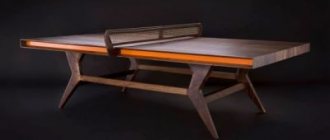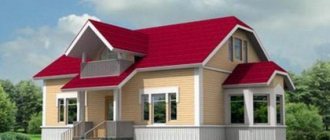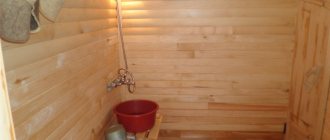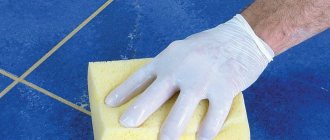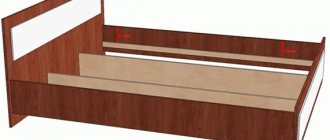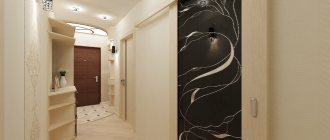Tables made of epoxy resin look incomparable - they will definitely decorate any room, be it a kitchen or a living room. And you don’t have to order them for a lot of money: you can try your hand at making such a table yourself, especially since it’s quite simple if you follow our step-by-step instructions with photos and take into account all possible mistakes. Besides, it won't cost very much.
Example of an epoxy resin table
Design and construction features
Epoxy resin tables are characterized by a unique design and can fit into any interior. Most often they are used in kitchens and living rooms, and there are no strict requirements for the style solution. Epoxy is used not only to make new products, but also to restore old furniture. Many models are made by combining several materials.
The peculiarity of the resin is that it hardly shrinks after hardening, therefore it retains its original shape for a long time. In addition, it can be decorated in different ways. Resin tables come in several types of designs:
- Combined. In this case, synthetic material alternates with wood elements.
- With the presence of support. Only the top layer is filled with resin. Additionally, various decorative elements are used: leaves, coins, flowers.
- Without the presence of support. There is only epoxy here. Small coffee tables are made this way. They are not intended for significant mechanical loads.
The product can be transparent, single-color or combined. The most commonly used are light turquoise and blue shades. Often the design is equipped with additional lighting or fluorescent powder. Handmade tables have a high cost, but such furniture can be made independently. The advantage of the process is that the cost of the model is reduced. There are other advantages: the opportunity to show imagination, restoring old furniture in an original way.
Combined
With the presence of support
Without the presence of support
Step-by-step filling of countertops with epoxy
To thoroughly understand how to fill a countertop with epoxy resin, you need to study the action plan exactly. After all, only in this case can we ensure truly high-quality work.
So, the epoxy countertop is made according to the following principle:
- Deciding on the fill. We advise you to try several brands at once, combining them with the selected wood, and determine the best option.
- Setting up the form. We check it for evenness using a building level.
- We process wood. We sand it, cover it with stain and varnish for better quality.
- We place the wood in the form and check its placement using a building level. We make sure that the product is well fixed.
- Using a drill attachment, slowly and carefully mix the mixture repeatedly. It is recommended to constantly pour the mixture from bucket to bucket to ensure that all ingredients are thoroughly mixed.
- Carefully pour the first layer of resin and check the thickness of the pour with a ruler. The manufacturer's instructions always contain information about the maximum permissible layer of material. Exceeding this norm may cause the resin to boil or be damaged during drying.
- If bubbles are created during pouring, they can be eliminated using a needle or disposable plastic fork.
- After the first layer has hardened, wipe the surface with a rag and acetone to remove dust.
- We repeat the filling according to the same principle. It is important that the first layer is the thinnest, so it must be applied with a brush.
- After the product has completely hardened, the edges of the tabletop can be trimmed and sanding can begin.
Recommendations for proper operation
Don’t forget to follow some rules when working with epoxy. To ensure that the result does not disappoint the master, be sure to take into account the following features:
- the resin hardens much faster in heat;
- the filling should not be heated from above, because this often promises deformation;
- while the fill is still hardening, it must be removed from direct sources of ultraviolet radiation, as it may turn yellow;
- remember that epoxy is toxic - work with it carefully;
- When kneading, make sure that your movements are smooth, because sudden movements of your hands will lead to the formation of bubbles;
- Do not leave the flooded product in the cold to avoid delamination;
- It is recommended to cover the finished layer with a protective varnish so that the product does not release toxins.
Epoxy countertop care
In fact, epoxy resin countertops do not require complex maintenance. It is important to remember that it is wiped only with soft fabrics. It is also prohibited to get acetone, alcohol solutions and hairspray on the product.
Working on creating an epoxy resin table is not as difficult a task as it seems at first glance. If you want to know more, we recommend that you pay attention to this video. Here is a comprehensive video on how professionals make tables from epoxy resin and wood (slabs):
Properties of epoxy resin
Epoxy resin is a synthetic oligomer material. It is not used in its pure form. To obtain a solid fragment, the resin must be polymerized using a hardener. Different proportions of components make it possible to create materials with different physical and mechanical properties. The resin has the following qualities:
- strength and resistance to chemicals;
- no unpleasant odor when working with epoxy;
- the polymerization process occurs at temperatures from -15 to + 80 degrees;
- slight shrinkage after hardening of the material, its stable structure;
- poor moisture permeability;
- high resistance to mechanical damage and abrasive wear;
- no need for expensive care.
When using additional protective components, such a table becomes immune to direct sunlight.
The resin also has some disadvantages: when exposed to high temperatures, it can release harmful substances. To work with the substance, you must have certain skills and fully comply with the application technology. Such material has a high cost.
Durable and chemical resistant
No unpleasant odor when working with epoxy
Minor shrinkage after hardening of the material
Weak moisture permeability
High resistance to mechanical damage and abrasive wear
No need for expensive maintenance
Plain or transparent tabletop
Making a table with a single-color tabletop begins with cleaning and degreasing the workpiece. If a material that absorbs liquids (for example, wood) is used as a base, then it must first be primed with resin. This will prevent bubbles from appearing during operation. The next step is to make an epoxy mixture and pour it into the mold.
If the table is to be made in color, then the appropriate coloring pigment must be added to the resin, and it is desirable that the dye be from the same manufacturer as the epoxy. If you want the color of the tabletop to be combined, then during the pouring process you need to use resin with dyes of several shades.
After pouring, you need to leave the countertop for 10-15 minutes, and then remove any bubbles if they appear. After two days, you can grind and polish the product. After a week, the table is completely ready for use.
Popular modifications
Making a table from epoxy resin is a task for a craftsman with good imagination. In addition to standard pieces of wood, luminescent paints or powders, buttons, wine corks, moss, plant leaves, sea stones, and cobblestones can be used for decoration.
River
A special feature of the river table design with epoxy resin is that it is based on the same placement of elements: an insert made of the specified material is localized between two pieces of wood. It can be straight or follow the curves of the tree, wide or narrow, with decorative fragments, islands, and stones.
The shapes of the tabletops here are different: round, oval, rectangular. Interesting options are in which wood plays the role of a river bank, and resin plays the role of water. These products can be installed in the living room and kitchen. The model looks great in the office. With a river you can make a coffee table in Provence or country style. As for material consumption, about 13-14 kg of substance is needed for a river measuring 210 x 15 x 5 cm.
Solid surface
To create a solid table made of liquid glass, you need to use a mold of the required size. Most often, such structures are made without support and do not provide for intense loads. Tabletops of this type are used for the production of coffee tables or dressing tables. To make an epoxy resin tabletop, the dimensions of which are 100 x 60 x 5 cm, approximately 30 liters of resin are required.
From slab
Slabs are solid massive slabs of wood or stone. To make such a product at home, lighter material is taken. The tree usually represents a longitudinal cut of the trunk with remaining knots and uneven edges. This will allow you to create a unique model.
Often a slab table is made of oak. In this format you can make a kitchen surface, a structure for a living room, or an office. The thickness of the wood material ranges from 5 to 15 cm. It should not be glued or have other joints. To make a table from medium-sized epoxy resin slabs, you will need about 10 kg of the substance.
From cuts
Solid wood tables look very original and rich. Models of saw cuts of wood material coated with an epoxy solution look no less impressive. To fill such a countertop, a minimum of 7 kg of polyester substances is required. This model is perfect for kitchens, cottages in country style, eco-friendly. No matter what kind of hemp or solid trunk the cuts are made from, the design of each of them will be unique.
Tables of this type have different shapes: round, oval, rectangular and even square. The number of fragments used depends on its choice. The material must be of high quality and the required diameter. Cracked elements are not recommended to be used.
Advantages of epoxy tables: simple production and original design
Originality is what initially attracts an epoxy table.
Advantages of liquid glass countertops:
- have increased strength;
- resistant to household chemicals;
- do not require special care or special care;
- are not deformed;
- do not attract dust;
- do not absorb water;
- not susceptible to ultraviolet radiation;
- wear-resistant.
Tables with epoxy resin with different proportions of materials can have a different set of characteristics. Therefore, the final result is limited only by the imagination of the master himself.
In addition, the undoubted advantage of the products is their versatility. For each interior you can find your own design.
Most often, such furniture is combined with the following styles:
- bionics;
- futurism;
- rustic;
- eco;
- grunge;
- loft;
- eclecticism;
- postmodernism.
If you are thinking about making a table with epoxy resin yourself, you can always find tips, master classes and photos on the Internet. Thanks to this, even a person without special experience will be able to create a real work of art.
What kind of tables can be made?
Separately, it is worth noting that with the help of epoxy and other polyester resins they make:
- dining tables;
- countertops for kitchen sets;
- kitchen island countertops;
- coffee tables and more.
Furniture decor has a lot of options: leaves, shells, moss, stones, pieces of wood. They create a unique pattern, which determines the originality of the model.
Updating an old table with epoxy resin
Even if the table has become dilapidated over time and under the influence of negative factors, it can not only be updated, but also made into an original piece of furniture. You can use photographs, buttons or coins for decoration. The work includes the following stages:
- Elimination of rotten and damaged areas, old paint. The surface must be thoroughly dried.
- Laying decorative elements. If they are light, then it is better to glue them to the base, otherwise they may float.
- Application of resin. The procedure is repeated several times with an interval of 2-3 days.
The dried layer should be sanded and varnished. Restoring or making tables from epoxy resin is not a technologically simple process. But if you follow all the nuances of the work, you can create a real masterpiece yourself.
DIY table - technology
When combining wood and resin, you also need to pay attention to the wood itself. Any piece of wood is not suitable for a tabletop; slabs are used for this purpose; these are pieces of expensive wood that are chamber dried. The most popular options are slabs made of oak, poplar, and ash. The species must be a hard wood.
When the material is available, they decide how it will be arranged. And they move on to preparing it. It is necessary to create a flat surface, it is processed with a milling cutter and sanded. Places that will come into contact with the resin must be covered with it. This will seal the holes to prevent air from escaping and causing bubbles to form.
During drying, the resin must warm up, those areas where bubbles appear are heated. After drying, the surface is sanded again and given an even coating.
Afterwards you can proceed to pouring the epoxy itself.
During drying, the resin must warm up, those areas where bubbles appear are heated.
Necessary materials
You shouldn’t be distracted when carrying out work, so it’s better to prepare the necessary materials and tools in advance. You will need:
- Epoxy resin;
- A corrector for epoxy resin, it helps to level the surface, or a gas burner, working with it is somewhat more difficult;
- Sealant for formwork processing;
- Separator, either wax, Vaseline, oil;
- Dyes, if necessary, give a different shade to the coating;
- Drill and screws;
- Level;
- Sander;
- Plane;
- Mixer;
- Glue;
- Plastic and materials for the formwork base;
- Containers for preparing the composition.
You shouldn’t be distracted when carrying out work, so it’s better to prepare the necessary materials and tools in advance.
Preparation of epoxy
Manufacturers include instructions with their products on how to prepare them for use. Preparation is carried out immediately before starting work. You must strictly follow the specified proportions and rules. Typically the composition consists of two components: resin and hardener.
If it is necessary to give the solution a certain color, the dye is added before mixing the composition with the hardener.
After thoroughly mixing the components, you can proceed to adding the hardener. Mixing is best done by hand; the components should be well mixed. In this process, bubbles may also appear; they are removed using a hair dryer, and this is done carefully.
Different viscosities are used for different types of tables:
- Liquid, drains easily, can fill all cavities, intended for coating using decorative elements;
- Semi-liquid is suitable for round countertops;
- Thick, used only for restoration work on vertical surfaces.
Preparation is carried out immediately before starting work.
Manufacturing process
The first step is to prepare a form into which the composition will be poured. For this purpose, he uses any type of smooth sheets; they are made higher than the thickness of the wooden parts, connect them together with sealant, carefully covering the joints so that the resin does not leak out through them.
If the resin is also on the edges of the tabletop, then the width of the mold is made larger than the wooden base. The sealant must be leveled after hardening.
Having placed all the necessary elements on the surface in the intended places, they proceed directly to pouring the resin. After all, it hardens quickly. You need to pour the prepared solution starting from the middle, so it will be evenly distributed over the surface. If the table is made large, then the filling is expanded. After filling the entire composition, it is leveled using a trowel. After leveling, leave the product to dry.
You need to pour the prepared solution starting from the middle, so it will be evenly distributed over the surface.

